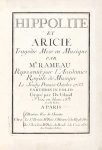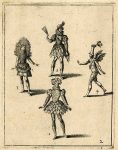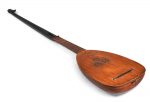Jean-Philippe Rameau (25 September 1683 – 12 September 1764) was one of the most important French composers and music theorists of the 18th century. He replaced Jean-Baptiste Lully as the dominant composer of French opera and is also considered the leading French composer for the harpsichord of his time, alongside François Couperin.
Little is known about Rameau’s early years. It was not until the 1720s that he won fame as a major theorist of music with his Treatise on Harmony (1722) and also in the following years as a composer of masterpieces for the harpsichord, which circulated throughout Europe. He was almost 50 before he embarked on the operatic career on which his reputation chiefly rests today. His debut, Hippolyte et Aricie (1733), caused a great stir and was fiercely attacked by the supporters of Lully’s style of music for its revolutionary use of harmony. Nevertheless, Rameau’s pre-eminence in the field of French opera was soon acknowledged, and he was later attacked as an “establishment” composer by those who favoured Italian opera during the controversy known as the Querelle des Bouffons in the 1750s. Rameau’s music had gone out of fashion by the end of the 18th century, and it was not until the 20th that serious efforts were made to revive it. Today, he enjoys renewed appreciation with performances and recordings of his music ever more frequent. Reference: Wikipedia
Rameau, Jean Philippe PIÈCES DE CLAVESSIN AVEC UNE MÉTHODE POUR LA MÉCHANIQUE DES DOIGTS, OÙ L’ON ENSEIGNE LES MOYENS DE SE PROCURER UNE PARFAIT EXÉCUTION SUR CET INSTRUMENT, PARIS: HOCHEREAU, BOUVIN & THE AUTHOR, [1724] FIRST EDITION, oblong 4to (c.24 x 33cm), 8 pages typeset, [1] & 33 pages of engraved music (and 2 blank), pages 3-6 contain the méthode ‘De la méchanique des doigts sur le clavecin’ (imprimatur: 9 January 1724), royal privilege dated 1 February 1724, eighteenth-century half calf with marbled boards and manuscript label, GEORGE MALCOLM’S COPY GIVEN TO HIM BY IMOGEN HOLST, final four leaves misbound (see note): with paper-loss to top or bottom margins restored (affecting paginations, small tears), binding worn but sound
Sold for 75,000 GBP at Sotheby’s in 2017
RAMEAU (JEAN PHILIPPE) Hippolite et Aricie. Tragedie mise en musique par Mr. Rameau. Representee par l’Academie Royale de Musique le Jeudy premier Octobre 1733. Partition in folio, gravé par De Gland, first edition, second issue (with “avec privilege du Roy” at foot of title in place of “Imprimé par Montule”), engraved throughout comprising title, list of actors, pages i-xxix (Prologue) and 1-206, without the “Changemens” and privilege leaf found in the first issue, some light browning and offsetting, contemporary French mottled calf, gilt panelled spine (chipped) [RISM A/I, R 148; cf. Hirsch II, 775], folio, Paris, chez l’hauteur, Boivin, Le Clerc, [c.1742] Footnotes RARE. RAMEAU’S CONTROVERSIAL FIRST OPERA, with a libretto by Abbé Simon-Joseph Pellegrin based on the story of Phedre. Premiered on 1 October 1733, the work’s innovative and difficult music (one trio was cut by the Opera) led to the musical debate which was to continue throughout the century, between the Ramoneurs on the one hand and the traditional Lullistes on the other; when the latter described Hippolite et Aricie as the first “Baroque” opera, it was used as a term of abuse. The present issue dates from the opera’s first revival in 1742, with numerous revisions, additions and cuts made by Ramneau in response to public demand, but also reflecting his own increasing maturity. No copies of any edition are recorded by ABPC as having sold at auction since 1975.
Sold for £ 3,360 inc. premium at Bonham’s in 2009
First edition of the first dance treatise to provide a complete codification of ballet arm positions—a major landmark in both ballet and data visualization. Malpied’s Baroque dance manual prescribes dance movements using the innovative notation system published in 1700 by Raoul Auger Feuillet—the coiner of the term chorégraphie. His method “shows a marked advance on the work of Feuillet and Rameau in the simplification of the recordings of dance steps” (Fletcher). With the standardization of five ports de bras, or arm positions, to match the five foot positions developed over the previous century, “the neoclassical demand to harmonise content and appearance had taken hold of the entire body” (Weickmann). Malpied, a dancing master who operated in the shadow of the Paris Opera, also describes here the minuet and l’allemande—two forms of popular dance in favor at the time. There is an undated second edition with 166 pages. Fletcher no. 37; Leslie, p. 337; Magriel, p. 82; Moroda, p. 378; see Dorion Weickmann, “The ballet d’action of the eighteenth century,” in The Cambridge Companion to Ballet (2007).
Octavo (204 x 145mm). [8 pp.] 122 pp. Entirely engraved. Engraved title signed Ribie’re; music and dance notation and diagrams throughout (slight darkening and soiling to title, dedication leaf strengthened at inner margin). Modern quarter calf over marbled boards (faint wear). Provenance: Edward Tufte (1942-present, pioneer in the field of data visualization and information design; bookplate, his sale, 2 December 2010, lot 51).
Sold for USD 6,000 at Christie’s in 2019
![Rameau, Jean Philippe PIÈCES DE CLAVESSIN AVEC UNE MÉTHODE POUR LA MÉCHANIQUE DES DOIGTS, OÙ L'ON ENSEIGNE LES MOYENS DE SE PROCURER UNE PARFAIT EXÉCUTION SUR CET INSTRUMENT, PARIS: HOCHEREAU, BOUVIN & THE AUTHOR, [1724]](https://antiquemusicals.com/wp-content/uploads/2019/07/jean-philippe-rameau-pieces-150x111.jpg)

![MALPIED (fl. 18th century). Traite´ sur l'art de la danse. Paris: M. Bouin, [c.1770]](https://antiquemusicals.com/wp-content/uploads/2019/01/musical-manuscript-dance-150x150.jpg)

